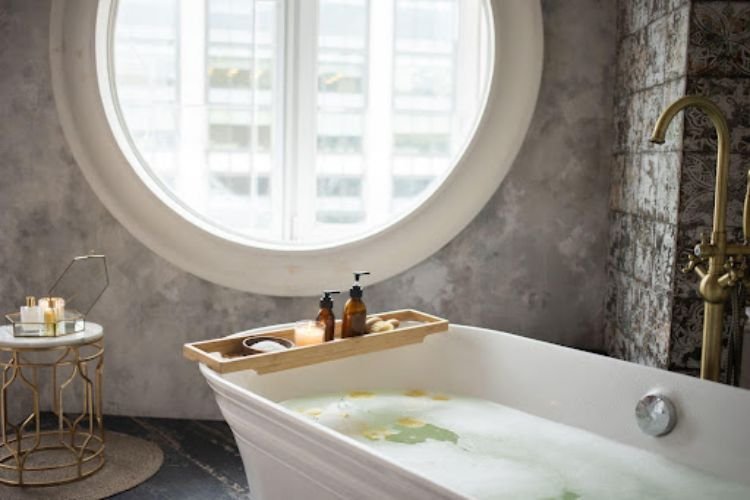 The bathroom is one of the most essential rooms in the home. A place of functionality, but also one in which to pamper, unwind, recharge, and seclude ourselves from the fast-paced world outside. Bathroom renovation is one of the most popular home improvement projects, but it’s easy to get it wrong. From clashing styles to sub-par fixtures and fittings, there are many problems that can arise. But with effective logistical planning and a clear aesthetic vision, you can create a perfect bathroom for your home. Here’s how.
The bathroom is one of the most essential rooms in the home. A place of functionality, but also one in which to pamper, unwind, recharge, and seclude ourselves from the fast-paced world outside. Bathroom renovation is one of the most popular home improvement projects, but it’s easy to get it wrong. From clashing styles to sub-par fixtures and fittings, there are many problems that can arise. But with effective logistical planning and a clear aesthetic vision, you can create a perfect bathroom for your home. Here’s how.
Planning
A great deal of planning is necessary before any home improvement project is started. Logistical and aesthetic aspects need to be considered – who will use the bathroom? If you have a family with children, for example, you’ll need to take that into account, as requirements will be different than those of an adult-only household. How long you want to spend doing the renovation is also a factor – set aside time in your diary if you’ll be doing it yourself, or get your contractors booked in as early as you can.
Design
Choosing a design concept is usually the most fun part of planning, as long as everyone involved can agree on a look and style. Bathroom minimalism is always in – chrome fittings, perfect white porcelain and sheer mirrors. But many designers are opting for warmer natural materials, or combinations of aesthetics – this adds depth and atmosphere without compromising a simple and functional colour palette.
Budget
Realism is the key to any budget. Bathroom renovation can be an expensive business, especially if you’re moving plumbed items around. Of course, not every renovation has to break the bank, sometimes small touches can make a big difference. Whatever your intentions, once you’ve budgeted, stick to the budget. This means sourcing everything you’ll need ahead of time, and getting quotes from contractors. And it’s best to put a sum aside for some bumps in the road, as there will probably be a couple.
Layout
The layout is important, especially as most of us have fairly compact bathrooms – you’ll need to make the space work for you. Make sure that all cupboards and cabinets have enough room for their doors to open and the contents be accessible. Often the small size of a bathroom has some bearing on the design itself – one of the reasons why white, minimalistic styles are so popular is to avoid the clutter and claustrophobia caused by busier designs. A cluttered space is not a relaxing one.
Bath and shower
A tub is often the centrepiece of a bathroom, and if you have the space, a free-standing one will look great. If you have a more compact space, Japanese soaking tubs, or ofuro, are on trend. Gone are the days of boring showers. You can transform your daily washing experience with a variety of shower heads, from classic round heads to contemporary square models, high and low-pressure varieties, and rainfall-style ceiling-mounted shower heads for the complete spa experience.
Basins and taps
Again, monochrome minimalism is the most common aesthetic you’ll find with basins and taps – porcelain with black brass is the contemporary classic – but more and more we are seeing alternative materials being used. Coloured ceramics are definitely on-trend, and can be found to suit pretty much any colour scheme. Taps come in all shapes and sizes, but the general rule of thumb is that brassware shouldn’t be cheap – it’s one area that experts recommend buying the best your budget will allow.
Natural materials
Many are opting for alternatives to traditional tiling and leaning towards using natural materials to add layers and depth to the bathroom. Natural stone is an excellent and warm material to use on the floor, and wood (or wood effect) has been successfully incorporated into many modern bathrooms and is a great way to broaden the colour palette without losing neutrality or practicality.
Lighting
The best source of light for any room is always going to be natural light, but many bathrooms have small, or even no, windows. Vanities and basins need to be well-lit – no one likes shaving or putting makeup on in the dark – so spotlights or similar task lighting should be used. But the bathroom is for pleasure as well as practicality. Many bathroom lighting solutions are available to suit all needs and budgets. These include dimmers, spot and wall wash lights, and recessed ceiling lights.
Colour
Determining a colour palette is an important part of getting the tone and atmosphere of your bathroom just right. Most designers agree that either white or bright, warm colours are best for smaller rooms. Some people do prefer to opt for bold, deeper colours such as dark red or a deep, aquatic blue – and these can work especially well in larger bathrooms. If your space is compact but you can’t resist bold colours, consider a feature wall.
If you’re planning to revamp your bathroom, following some of these tips should help you get started. With a bit of planning and a clear design concept, you’ll be well on your way to creating the perfect bathroom for your home.




